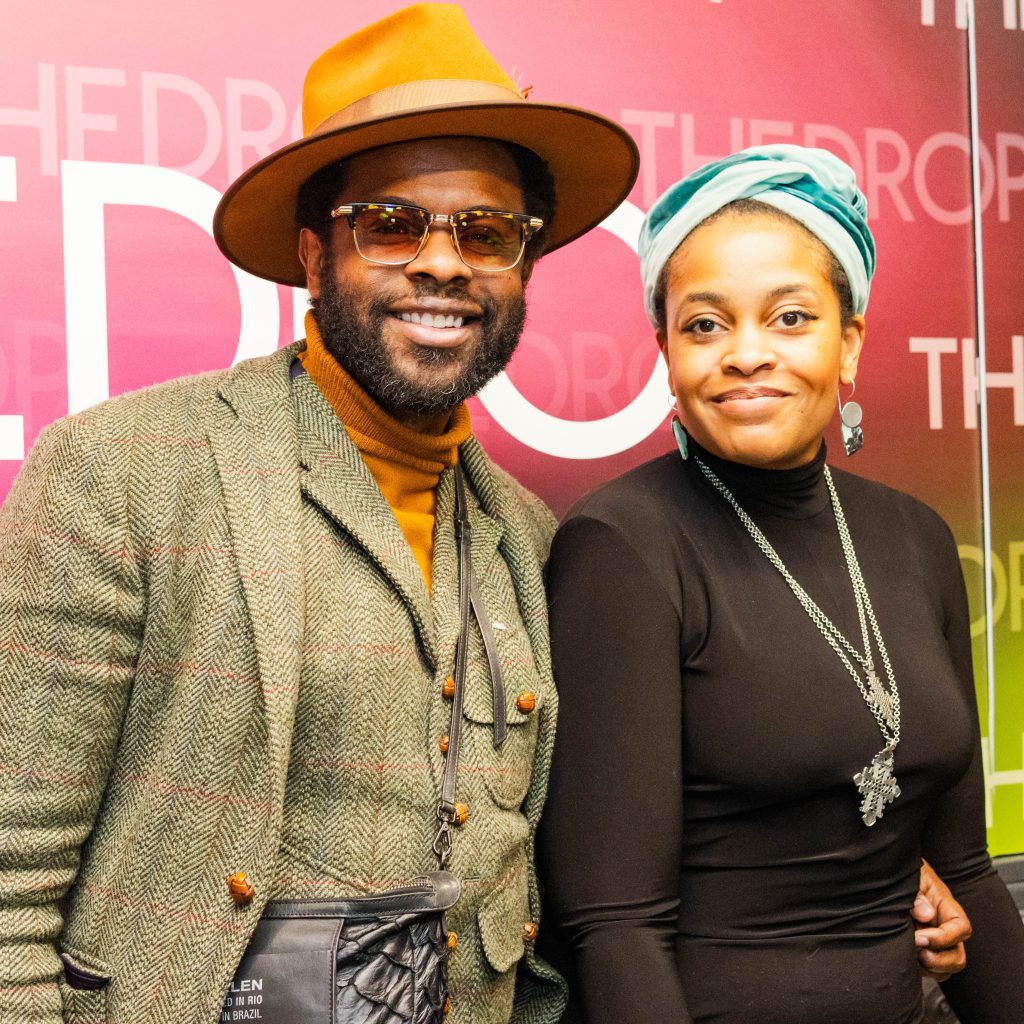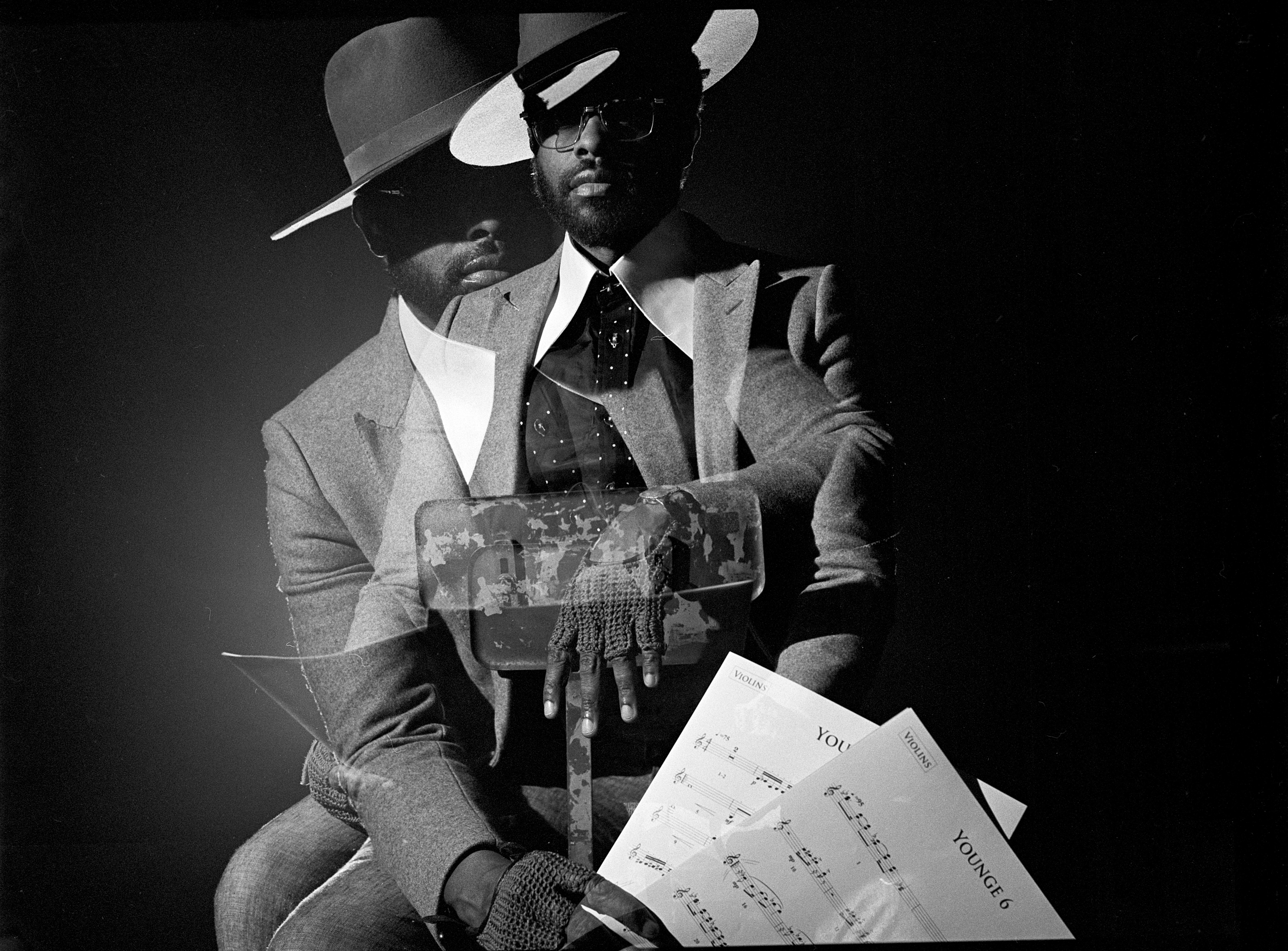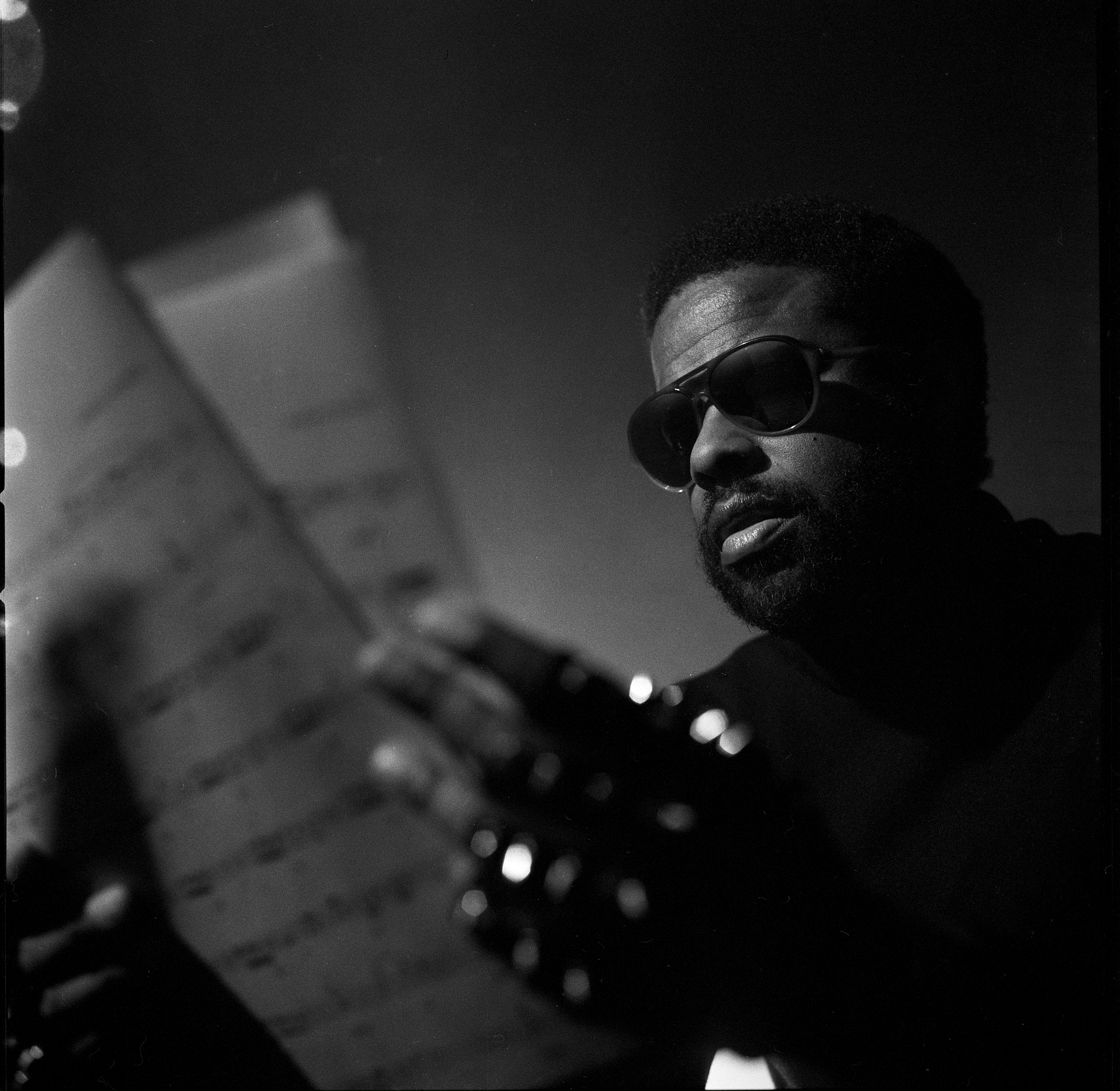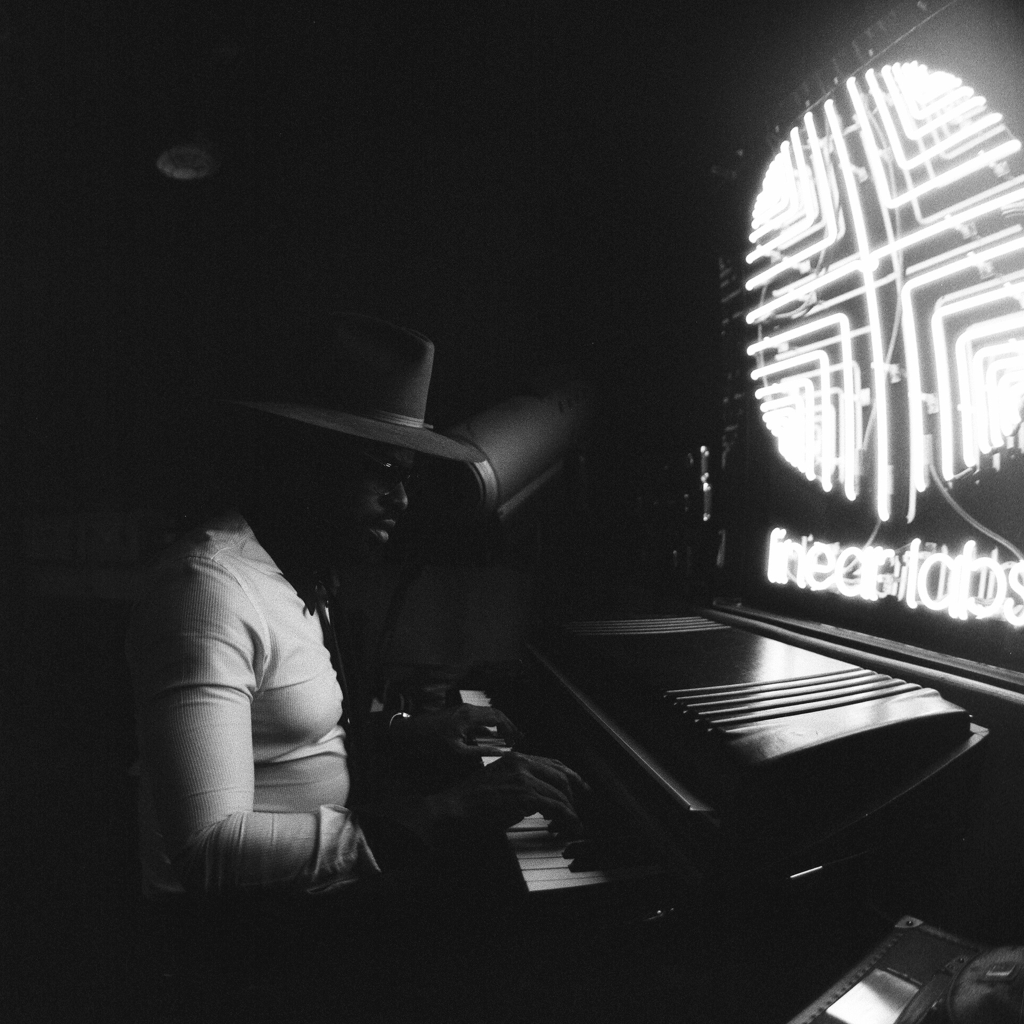Latest posts by Ayana Contreras
(see all)
In March of 2025, artist/producer extraordinaire Adrian Younge visited Denver and sat down with Ayana Contreras. The pair discussed the birth of his labels, Linear Labs and Jazz is Dead, and what inspires his work, that features collaborations with artists ranging from Snoop Dogg and Ali Shaheed Muhammad to Roy Ayers.

AYANA CONTRERAS: All right. I’m Ayana Contreras here at KUVO Jazz & The Drop, and I’m here with Adrian Younge, who I’ve actually never had a long-term conversation with. I feel like I’ve seen you a million times because you’re so… what’s the word? Prolific. So, officially welcome.
ADRIAN YOUNGE: Thank you so much. It’s an honor to be here with you.
AYANA: Thank you. So, the reason for the season, I guess, is there’s Something About April 3, which when we’re recording this interview, it hasn’t exactly dropped yet, but it’s about to drop.
ADRIAN: Yeah.
AYANA: It’s the third in your trilogy. The first one was what, 2011? Is that right?
ADRIAN: Yes, 2011.
AYANA: So, what made you decide that it was going to be a three-part series?
ADRIAN: For me, I have a very deep catalog, but there’s the Something About April album when it was released, kind of really let people know who I am. You know, it’s the most Adrian Younge-centric album out of everything I have because I do different types of music and also that album is the most sampled album I have.
So, when I did part two, I wanted to kind of continue the story of part one. So sonically the story is just the kind of stuff that like let’s say a Riza and Ennio Morricone would have made in 1972, had they been working together. But story-wise, it’s about love. And it’s something that I deem as being this kind of dark, cinematic psych soul thing, you know?
Because a lot of people, when they listen to music from the ’60s, late ’60s, early ’70s, a lot of that romantic music is dark for today’s standards because hip-hop changed the way we hear old music. There’s certain things that hip-hop has sampled, and the derivative music has this dark kind of grimy connotation to it. So now when people hear samples like that, they think it’s dark.
So anyway, I wanted to create a series that was cinematic, but then had all these kind of hip-hop sentiments to it, like the kind of stuff that hip-hop artists would want to sample.
AYANA: Exactly.
ADRIAN: So, I did that in part one, part two, and with my forthcoming part three, it’s just kind of wrapping up that world. So if you listen to one, two, and three, it all kind of feels like you’re in that world basically.
AYANA: So, let’s back up a little bit. You mentioned a couple of things, one of which was that you have a deep catalog, which is true. So, there’s people out here that maybe don’t even know your name, but know your work, know the Jazz is Dead stuff that you did with, you’re constantly doing with Ali Shaheed Muhammad, right? There is the Midnight Hour specifically. There is the Snoop stuff that just came out. There’s the Loren Oden stuff. There’s a wide variety of things that you’ve been involved in.
What I think my entry point to you, I wasn’t like hip way in the very beginning, it was actually the record that you did with The Delfonics’ Wilbert Hart, which was crazy.
ADRIAN: Thank you.
AYANA: Crazy.
ADRIAN: Yeah, with William, Wilbert’s his brother.
AYANA: William. You’re right, you’re right. William Hart.
ADRIAN: Yeah, yeah, yeah. Yeah, no. That’s something that I think is beautiful.
With me touring with all the traveling I do, one of the things people come up to me and say, “My entry point to you was…” and I think about where I was at that time and where I am now, and it’s just, I always tell artists, right, when they’re working 10 years on making their first album, I’m like, “Yo, just get it out because you’re going to keep making stuff and it’ll be better. But some stuff is made for some people, right? Like this journey you’re on, people need to hear that. But the stuff you’re doing in 10 years, they need to hear that. But like when they hear the stuff that you did in 10 years, it’ll take them back to what you did in the first year, the second year, you know?” So I’m always excited to hear how people became familiar with my music.

AYANA: Absolutely. So, tell me a little bit about the Jazz is Dead series.
ADRIAN: Yeah.
AYANA:
So, basically, it’s taking these like really sometimes under-sung, sometimes underground, but always beloved artists from a variety of different backgrounds that are kind of in that jazz space or rare groove space and producing all new recordings with them. So, you did Roy Ayers, Jean Carne, Azymuth, a wide variety of folks. What was the impetus for that series?
ADRIAN: I’ve always wanted to have a jazz label. And the reason is, and I know you’ll understand this, is that there’s something about listening to jazz records in the ’60s and ’70s that we lost. And a big part of what we lost is how it sounds.
So, for the listeners out there that may not know me, I’m a hardcore analog dude. There are no computers in my studio. Everything’s recorded in two-inch tape. It’s mixed down to tape. It’s all live instrumentation. I do things the way that they did back then, but with the ear that hip hop has provided. So, my bass is going to be a little fatter. My drums are going to be a little more grimier and bigger, but I’m all analog.
So, I wanted to create a record label that speaks to that sound. So myself and Ali Shaheed Muhammad together, we make most of the records. And when we started, we were going around to different labels like Blue Note or Concord, and saying, “Yo, we want to do something that’s like jazz, jazz adjacent all analog, and we could knock out all these albums in this amount of time.” And we had this crazy concert series that we’re going to be doing, and everyone loved the idea and everyone wanted to be down with it, but it was hard for them to kind of quantify, because what we were saying, it would be kind of prolific if we actually put that together.
So, we realized that, “You know what? We just got to do this.” And when I say we, it’s myself, Angela Harrow, Adam Block, and Ali Shaheen Muhammad. So we just said, “All right, let’s start recording these albums. Let’s start doing these concerts and let’s just pay for it ourselves and figure it out.” Because for us, it’s more passion than product. It’s just like we’re passionate about doing this.
So, we were able to get with legendary artists and make new albums with them and bringing them into the same kind of circumstances that they had when they recorded their classic albums. So doing an album with Gary Bartz doing an album with Roy Ayers, Doug Carn, Jean Carne, Lonnie Liston Smith, Marcos Valle, João Donato, Azymuth, Brian Jackson, I could go on and on. But we’ve been able to not only do these albums, but have these albums chart like our Ebo Taylor album that we did right now has been on like number one on the jazz charts for like weeks.
Before Tony Allen passed, I did an album with Tony Allen. We’ve been able to shine light on many people that have been forgotten, and we’ve been able to focus on giving these living legends their flowers.
And how this coincides with the concerts, we do big concerts with these people. And a lot of these people, humbly speaking, if we weren’t involved, they would be playing at the small jazz club on the corner versus playing for thousands of people across the U.S. and many other places in the world.
We’ve been able to build a built-in audience that kind of trusts our Jazz is Dead brand. So when we say, “Hey, you need to come to this show,” or, “you need to listen to this record,” they trust us and they come out in droves. And it’s been one of the most phenomenal experiences that I’ve been a part of in my life, to be honest with you, because this is not supposed to happen.
You’re not supposed to release a brand-new album with a 90-year-old artist from Ghana [Ebo Taylor] and have people go that crazy about it. You’re not supposed to do a tour with a 90-year-old from Ghana and sell out shows across the U.S. It’s like this is not supposed to happen. So, we’re thankful for everything that’s happening. And again, it’s the passion that drives us because it’s definitely not the money. It’s all like the love and the crying that we have together, the energy that we share, the meals that we share.
With Roy Ayers recently passing, thinking about those very precious, precious moments. It’s not even about the music, it’s not even about the concerts. It’s us sitting in the car driving to our favorite place to eat. It’s those moments that help us associate ourselves even more with the records that they made and why they did. And then we get an opportunity to continue their conversations and share their messages with a large demographic of people. It’s all dream come true stuff. So that’s essentially what Jazz is Dead is.
AYANA: But then also speaking to how these records are not just crystallized in the past and what they have to say is not crystallized in the past, right? So I’ll give you an example. I’ve seen a bunch of the shows, maybe the most memorable one for me, it was late February of 2020 at The Lodge Room in Los Angeles. It was Lonnie Liston Smith. And it was wild because I wasn’t necessarily… I was not sure if I was going to get on the plane and do it, and it was last minute, and I said, “Let me go ahead and do it.” I don’t know. And I went and spectacular, I’d never seen Lonnie Liston Smith. And I know that at that time, he wasn’t really performing out and about that much. And so it was a fabulous show.
So fabulous that there was a point in the middle where this guy behind me was talking to this other guy about some nonsense. And I had turned around and I said, “Look, I flew all the way out here from Chicago to see this show. Can you please take this conversation outside?” And he was like, “I’m so sorry.” And he walked out. But it was just like that concert literally took me through the pandemic. Because there was a point where we were all like, “Is this all there is?” You know what I mean? But I want to thank you for that.

ADRIAN: Wow. I want to thank you too, because Jazz is Dead is like a big organism and we just happen to be part of it. But you’re just as much a part of it as we are because we’re creating this stuff for us and it can’t survive unless people like you are integrally involved and care.
Because what Jazz is Dead really is about, is us essentially being arbiters of cool, first and foremost. People trusting our taste, and then coming out to the concerts and seeing people that they never heard of and/or thought they’d never see live, and then telling their friends so that when we do the next concert, it’s double the capacity.
And this whole thing has been something that I don’t know where it’s going to go. I don’t know what it would have been if we worked with some of these major labels that’s happening now. And I can’t wait to look back one day and think about the history that we all collectively have made.
Because the Lonnie Liston Smith thing, I never ever thought I’d meet him in my life. I never ever thought he’d one day come in and play my Fender Rhodes piano. I never thought I’d be writing music for him. I never thought he would say, “Hey, that was a great take.” It’s beautiful what’s happening.
And what’s strange about it is that with the Jazz is Dead stuff, it’s a massive amount of work. And what that means is that the institution gets love for shining light on great people. And that’s a beautiful thing because it’s not an individual thing. It’s about us pointing the light towards these legends. And some of these legends aren’t even here with us anymore, but people are aware in a time where everything is very digital, very digital.
And also when you talk about the pandemic, when I was on the stage last night, I talked about, “We didn’t know if we’d have these moments together again, sharing energy and being in that moment,” you know? So like, “We can all come together.” And when I say, “we,” it’s people that have the knowledge of all these great records and all these great people can come together to make these artists cry on stage. And it’s happening all the time.
AYANA: Yeah. And another full circle moment, I write for DownBeat. And so I remember there was a lot of conversation about putting y’all on the cover, and I was like, “You really want to get behind this. This is a big thing.” And they did, and it was a little controversial because Jazz is Dead, people get mad about that, but ultimately it was on the right side of history.
ADRIAN: It was a big deal.
AYANA: Yeah.
ADRIAN: I remember going down there and just thanking them. Because it’s interesting, they were saying how they actually… I forget the editor’s name. He’s such a nice guy.
AYANA: You talking about Frank [Alkyer]?
ADRIAN: I think so…
AYANA: Yeah.
ADRIAN: And he said, “But we wanted to wait a little bit to make sure this wasn’t a fad.” And he saw that we kept going and it was just an honor because with the Jazz is Dead stuff, it’s a rhetorical statement that makes people think about things and people make choices. So you either really, really, really get it or you don’t get it, there’s no in-between.
But when you really, really get it, it galvanizes people like us to come together to put our hands up for culture. So the people that don’t get it, we’re also in the past, but we are in the past to shed light for the future and educate people. There’s some people that are just in the past and just think that everything back then was good and nothing can ever happened again. And that’s cool if they think that, but we ain’t about that. We about educating people and following our passions through culture.
AYANA: Absolutely.
ADRIAN: Yeah.

AYANA: So, to that point, as we wrap things up back to Something About April III and Sao Paulo, which I feel like kind of are speaking, they’re literally speaking a similar language.
ADRIAN: Absolutely.
AYANA: But they’re of a universe, the Linear Lab stuff that you’ve been putting out as of late.
ADRIAN: Yes.
AYANA: Tell me about that. I read somewhere, “That when you first started on this journey, you’ve really gone deep in so many ways.”
ADRIAN: Yeah. So essentially, in closing up the trilogy, I thought about, “What would make me really want to listen to something like that if I was a fan?” And just to kind of put this in perspective, I always tell people, “I live in this false reality because there’s this false audience in my head, this fake audience in my head, and I create art for them.” And I feel that a real artist, when they start creating art for people outside of the audience in their head, it’s hard to come back.
So, when I asked myself, “What would be the biggest chance I could take in doing a third installment of an album?” What I did was based on all of the inspiration I’ve had in all of my travels to Brazil, digging through the vinyl, working with these iconic Brazilian legends from the ’60 and the ’70s, I decided to make Something About April III all in Portuguese. And I spent time studying the language. I speak Portuguese, I’m not fluent, but I’m quasi fluent. And I wrote all the lyrics for it. And I wanted to create an album that was like a psychedelic soul jazz album that would have came out in ’71 based in Sao Paulo, during the time of the Brazilian dictatorship.
And we’re doing a massive tour for the Something About April stuff. And we’re bringing out different legends like Hyldon and Carlos Dafe, Marcos Valle, many different people to share the stage with me with a big 40 piece orchestra to do this. So again, when I say, “Living by what we passionately believe in,” that’s exactly what this all is. And that’s what Something About April III is.
AYANA: Amazing. It’s so wild. Hyldon is another one I saw at Lodge Room. I never thought I’d hear “Bicicleta” live. Insane.
ADRIAN: Yes. Yo, yo, yo, yo. So first of all, listeners, if you don’t know who Hyldon is, you need to listen because there was a movement… And I’ll try to keep this concise. In our post-civil rights movement here in the U.S., when our Black consciousness was being more realized, we inspired the world and Brazil specifically.
See, when you see pictures of Brazil, you see light skinned Latinos. But Brazil is actually 85% Black. And there’s a movement that where they would have these Black baladas and they would have all of these different parties in this and make different music to show their kinship to their brothers and sisters in the U.S.
Now, Hyldon, when he made that album where “Bicicleta” is on, he was on Polydor. They were doing their version of Black American soul in Portuguese for Brazil under a dictatorship that didn’t want any kind of racial conflict, even though there was a whole bunch of injustice going on. So when you guys start digging into this Black music of Brazil in the late ’60s, early ’70s, the samba funk stuff, their quasi soul stuff, it’s amazing. And I have a new album for on Jazz Dead with Hyldon coming out. We have a couple of singles out right now with Ivan Mamao Conti from Azymuth, who’s no longer with us. That was like one of his last recordings.
But there’s all of this great stuff that has happened out there, dig into some Brazilian stuff and it’ll just mess you up because you’ll hear how close that music is to the music of the U.S. of the time, but with a different sound and texture. Moreover, because they were under a dictatorship that didn’t like Black people. So, there’s levels to all of this stuff.
But anyway, that’s what we’re doing, and it’s an honor to be able to even talk to you about this because no one should care, to be honest with you. We care because we’re weird and we love this stuff. But I appreciate you.
AYANA: Amazing. I appreciate you, Adrian Younge.
ADRIAN: Thank you.
AYANA: Thank you so much.
ADRIAN: Thank you, mutual.